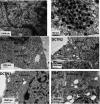Cellular and Viral Determinants of HSV-1 Entry and Intracellular Transport towards Nucleus of Infected Cells
- PMID: 33472938
- PMCID: PMC8092704
- DOI: 10.1128/JVI.02434-20
Cellular and Viral Determinants of HSV-1 Entry and Intracellular Transport towards Nucleus of Infected Cells
Abstract
HSV-1 employs cellular motor proteins and modulates kinase pathways to facilitate intracellular virion capsid transport. Previously, we and others have shown that the Akt inhibitor miltefosine inhibited virus entry. Herein, we show that the protein kinase C inhibitors staurosporine (STS) and gouml inhibited HSV-1 entry into Vero cells, and that miltefosine prevents HSV-1 capsid transport toward the nucleus. We have reported that the HSV-1 UL37 tegument protein interacts with the dynein motor complex during virus entry and virion egress, while others have shown that the UL37/UL36 protein complex binds dynein and kinesin causing a saltatory movement of capsids in neuronal axons. Co-immoprecipitation experiments confirmed previous findings from our laboratory that the UL37 protein interacted with the dynein intermediate chain (DIC) at early times post infection. This UL37-DIC interaction was concurrent with DIC phosphorylation in infected, but not mock-infected cells. Miltefosine inhibited dynein phosphorylation when added before, but not after virus entry. Inhibition of motor accessory protein dynactins (DCTN2, DCTN3), the adaptor proteins EB1 and the Bicaudal D homolog 2 (BICD2) expression using lentiviruses expressing specific shRNAs, inhibited intracellular transport of virion capsids toward the nucleus of human neuroblastoma (SK-N-SH) cells. Co-immunoprecipitation experiments revealed that the major capsid protein Vp5 interacted with dynactins (DCTN1/p150 and DCTN4/p62) and the end-binding protein (EB1) at early times post infection. These results show that Akt and kinase C are involved in virus entry and intracellular transport of virion capsids, but not in dynein activation via phosphorylation. Importantly, both the UL37 and Vp5 viral proteins are involved in dynein-dependent transport of virion capsids to the nuclei of infected cells.Importance. Herpes simplex virus type-1 enter either via fusion at the plasma membranes or endocytosis depositing the virion capsids into the cytoplasm of infected cells. The viral capsids utilize the dynein motor complex to move toward the nuclei of infected cells using the microtubular network. This work shows that inhibitors of the Akt kinase and kinase C inhibit not only viral entry into cells but also virion capsid transport toward the nucleus. In addition, the work reveals that the virion protein ICP5 (VP5) interacts with the dynein cofactor dynactin, while the UL37 protein interacts with the dynein intermediate chain (DIC). Importantly, neither Akt nor Kinase C was found to be responsible for phosphorylation/activation of dynein indicating that other cellular or viral kinases may be involved.
Copyright © 2021 American Society for Microbiology.
Figures








Similar articles
-
Herpes simplex virus 1 protein UL37 interacts with viral glycoprotein gK and membrane protein UL20 and functions in cytoplasmic virion envelopment.J Virol. 2014 Jun;88(11):5927-35. doi: 10.1128/JVI.00278-14. Epub 2014 Mar 5. J Virol. 2014. PMID: 24600000 Free PMC article.
-
A null mutation in the gene encoding the herpes simplex virus type 1 UL37 polypeptide abrogates virus maturation.J Virol. 2001 Nov;75(21):10259-71. doi: 10.1128/JVI.75.21.10259-10271.2001. J Virol. 2001. PMID: 11581394 Free PMC article.
-
Herpes Simplex Virus 1 UL37 Protein Tyrosine Residues Conserved among All Alphaherpesviruses Are Required for Interactions with Glycoprotein K, Cytoplasmic Virion Envelopment, and Infectious Virus Production.J Virol. 2016 Oct 28;90(22):10351-10361. doi: 10.1128/JVI.01202-16. Print 2016 Nov 15. J Virol. 2016. PMID: 27630233 Free PMC article.
-
HIV-1 Engages a Dynein-Dynactin-BICD2 Complex for Infection and Transport to the Nucleus.J Virol. 2018 Sep 26;92(20):e00358-18. doi: 10.1128/JVI.00358-18. Print 2018 Oct 15. J Virol. 2018. PMID: 30068656 Free PMC article.
-
Transport and egress of herpes simplex virus in neurons.Rev Med Virol. 2008 Jan-Feb;18(1):35-51. doi: 10.1002/rmv.560. Rev Med Virol. 2008. PMID: 17992661 Review.
Cited by
-
Engagement of Neurotropic Viruses in Fast Axonal Transport: Mechanisms, Potential Role of Host Kinases and Implications for Neuronal Dysfunction.Front Cell Neurosci. 2021 Jun 21;15:684762. doi: 10.3389/fncel.2021.684762. eCollection 2021. Front Cell Neurosci. 2021. PMID: 34234649 Free PMC article.
-
The intracellular bacterium Orientia tsutsugamushi uses the autotransporter ScaC to activate BICD adaptors for dynein-based motility.Nat Commun. 2025 Jul 3;16(1):6122. doi: 10.1038/s41467-025-61105-5. Nat Commun. 2025. PMID: 40610402 Free PMC article.
-
A review of HSV pathogenesis, vaccine development, and advanced applications.Mol Biomed. 2024 Aug 29;5(1):35. doi: 10.1186/s43556-024-00199-7. Mol Biomed. 2024. PMID: 39207577 Free PMC article. Review.
-
MLKL‒OPTN axis regulates herpesvirus-induced neurological sequelae.Clin Transl Med. 2025 Jun;15(6):e70353. doi: 10.1002/ctm2.70353. Clin Transl Med. 2025. PMID: 40490945 Free PMC article.
-
Anti-viral activity of Staphylococcus aureus lysates against herpes simplex virus type-I infection: an in vitro and in vivo study.Int J Ophthalmol. 2021 Oct 18;14(10):1463-1472. doi: 10.18240/ijo.2021.10.01. eCollection 2021. Int J Ophthalmol. 2021. PMID: 34667721 Free PMC article.
References
Grants and funding
LinkOut - more resources
Full Text Sources
Other Literature Sources

